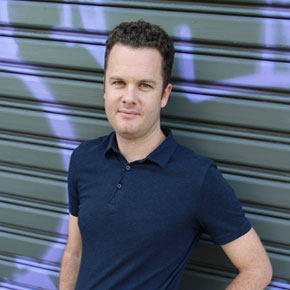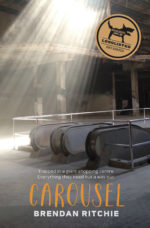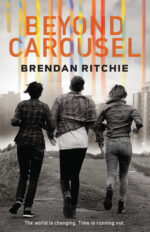Brendan Ritchie, author of Carousel and Beyond Carousel, talks dystopian futures and Beyond the Dark, an upcoming collection for teachers and students

We were lucky to chat with dystopian aficionado Brendan Ritchie about his chapter in the newly released book Beyond the Dark: Dystopian Texts in the Secondary English Classroom (edited by Patricia Dowsett, Ellen Rees and Alex Wharton, and published by the Australian Association for the Teaching of English). Brendan is well positioned to discuss dystopian fiction, with his Gold Inky Award longlisted debut novel, Carousel, exploring a dystopian Perth. The sequel, Beyond Carousel, continues to explore a post-apocalyptic world while raising pertinent questions about our own reality.
Tell us what Beyond the Dark is about.
Beyond the Dark is a collection of essays exploring various aspects of dystopian fiction. The rich and varied history of the genre; the characters who inhabit these narratives and the lands that they roam; the politics and social commentary embedded within each novel.
Tell us about your chapter in the book.
My chapter is titled ‘Imaginative Writing – Building Dystopian Worlds’ and offers some guidance and frameworks for students on how to go about developing their own dystopian environments (on the page, not in real life!). The chapter uses my novels Carousel and Beyond Carousel to explore some approaches to world building, temporality and character motivation. Speculation about the future is also a prevalent theme in the chapter, prompting students to consider where we might be headed as a society.
What do you hope the new book will achieve?
It’s designed as a guide for teachers looking to navigate dystopian texts with their students. Many of the chapters will assist teachers and students in understanding these texts on a critical level. Others, like mine, will provide some strategies and exercises that can hopefully be used to prompt and inspire writing from the students within the genre.
Is dystopian fiction taught in schools right now? Should it be something teachers focus on in the current climate?
Classic dystopian novels like 1984 and Tomorrow When the War Began still appear to be popular choices in the classroom. In many respects we’re living in a dystopian world right now. People are sick, isolating, wearing masks in supermarkets. And not long before this, half of the country was on fire. It’s all pretty terrifying. Young people could probably do with more tools to make sense of the world around them. Dystopian fiction has always offered a safe place to explore our fears about the present and future.
How important is the dystopian genre in teaching people to think about or question their own world?
Dystopian texts can be quite prophetic. Even a novel like Carousel which has people isolating in a shopping mall doesn’t feel so bizarre all the sudden. This gives the genre a strong cultural currency. It can encourage us to question how our actions today may shape the future in any number of ways.
What would you most like teachers to know about dystopian fiction?
There are some brilliant dystopian novels set in our own backyard. Perhaps rather than a 1984, students might appreciate reading something closer to home such as Charlotte Wood’s The Natural Way of Things, A.J. Betts’s Hive or Carousel.
What can kids learn from this kind of novel?
Readers will take what they choose from any given novel. That’s the beauty and the mystery of the whole writer–reader relationship. What I hope young readers might take from dystopian novels is that they still have agency over their future. Even within the darkness of a dystopia, there is still a fight to be had. Still things worth holding onto. And there’s no rule to say that dystopia is the end point. Something has to come next and young people will have the biggest say in that.
You can buy Brendan’s books Carousel and Beyond Carousel through the Fremantle Press website, and keep updated on his work here.




